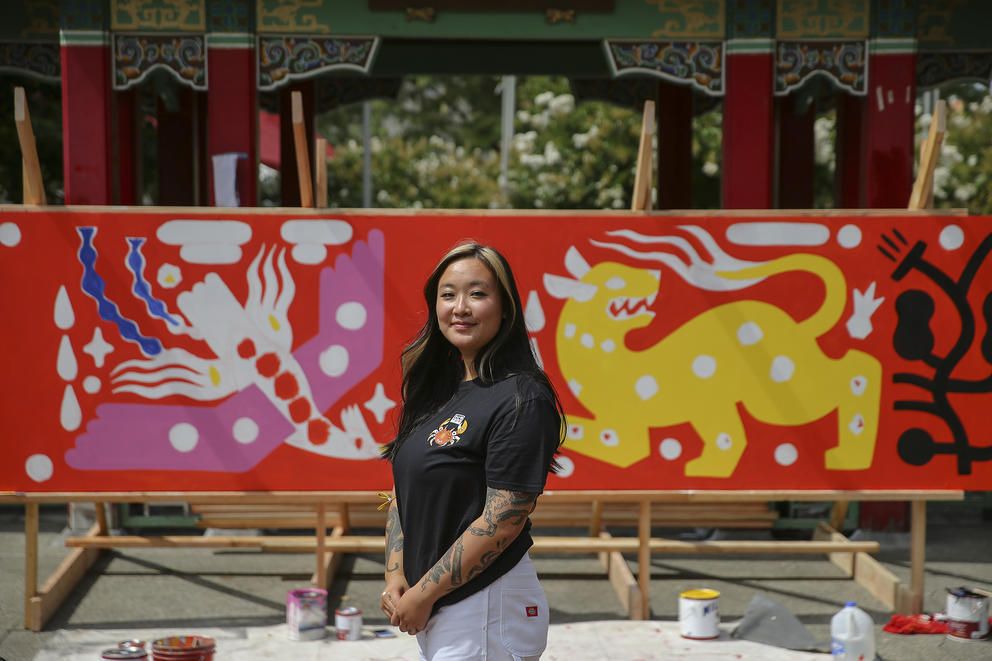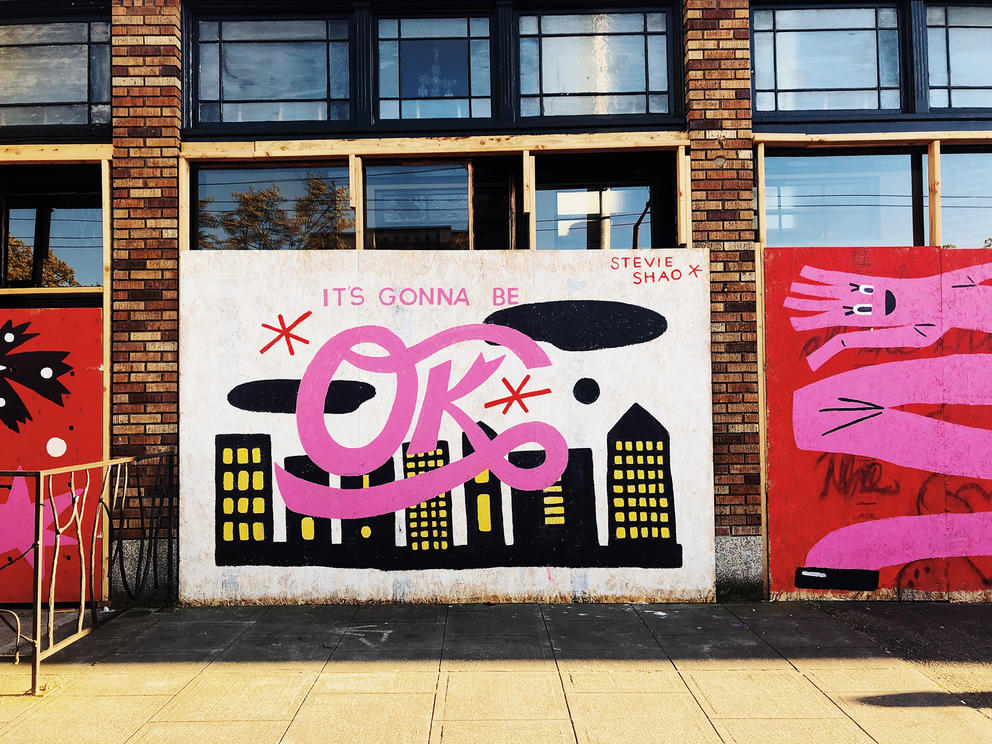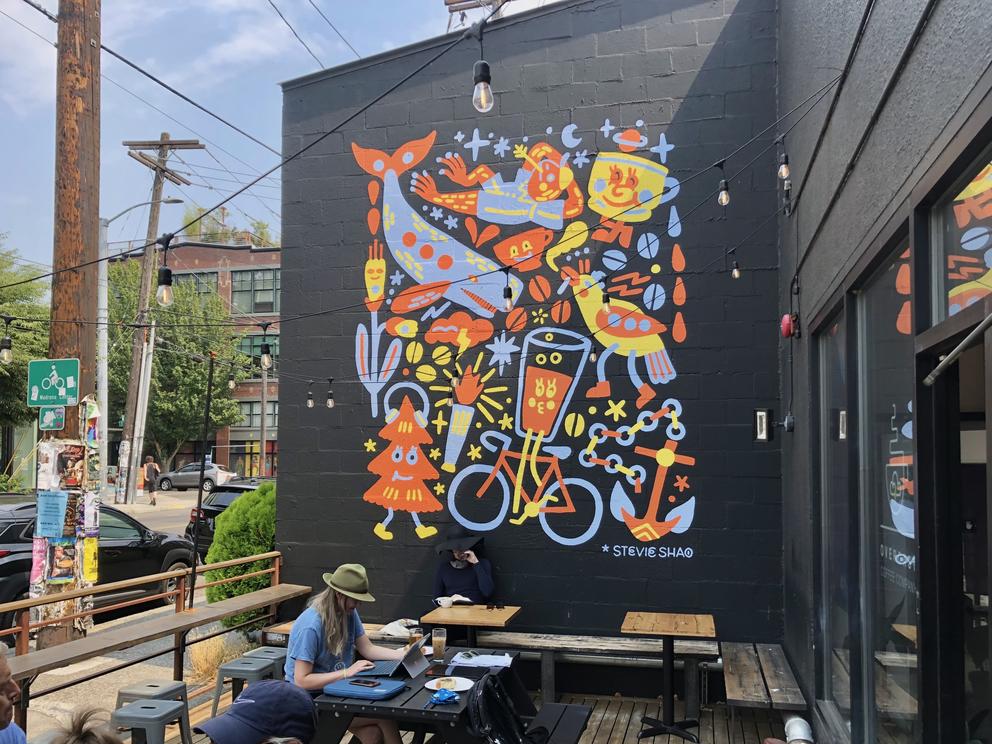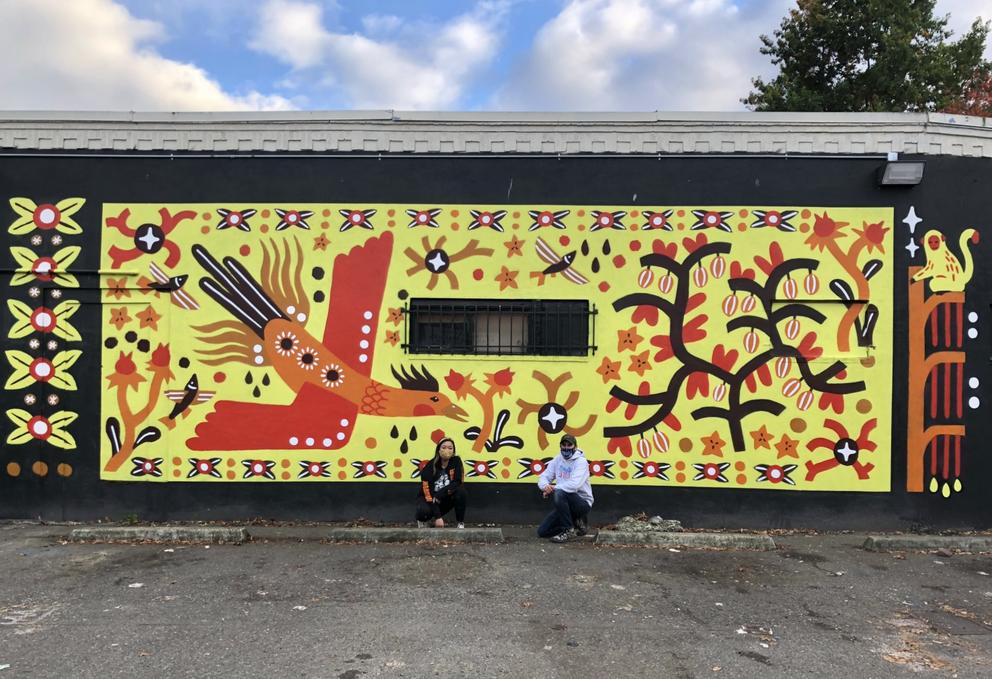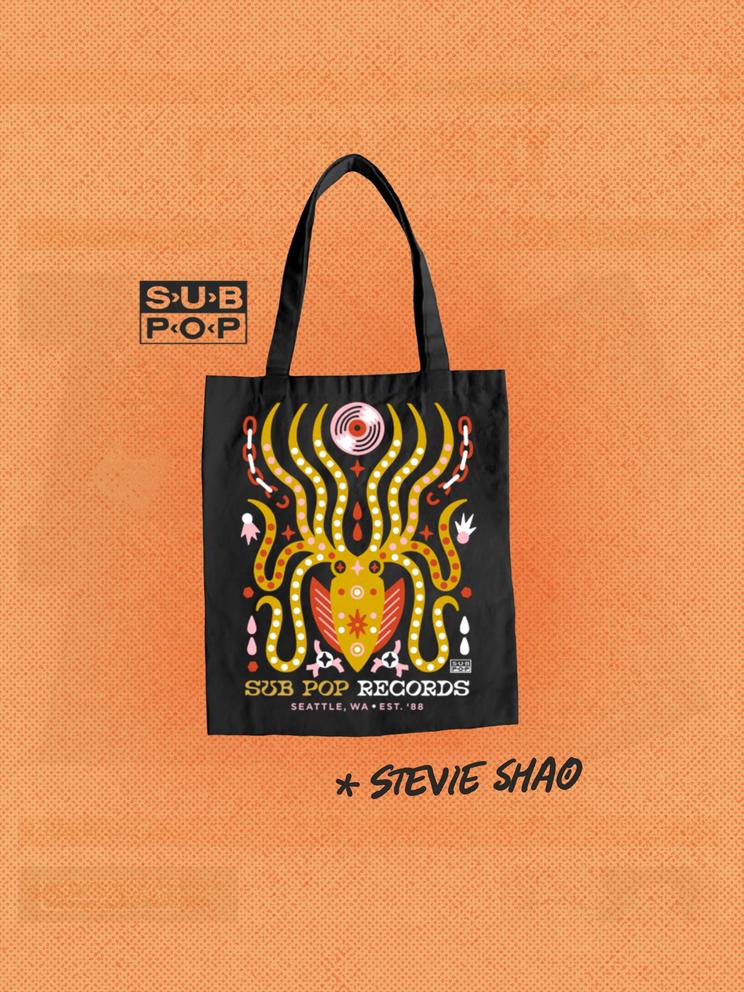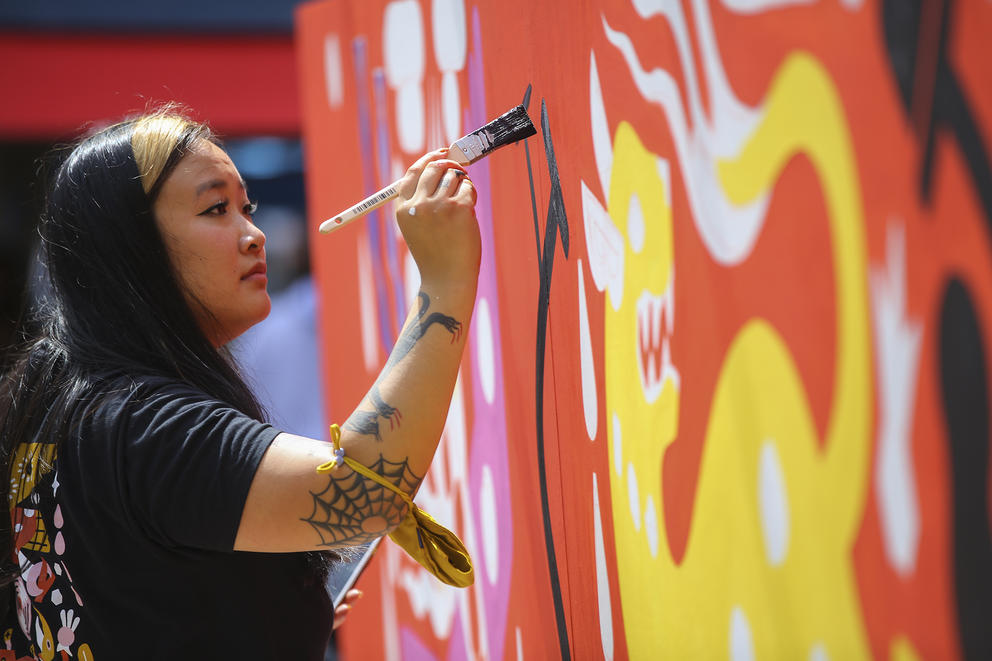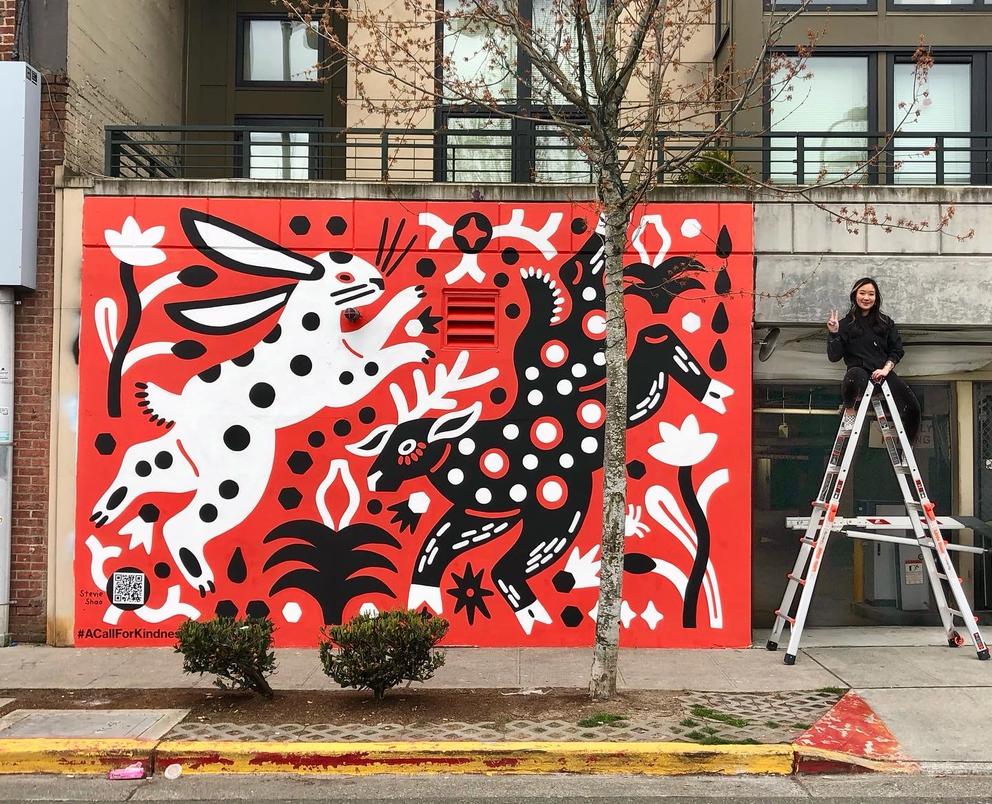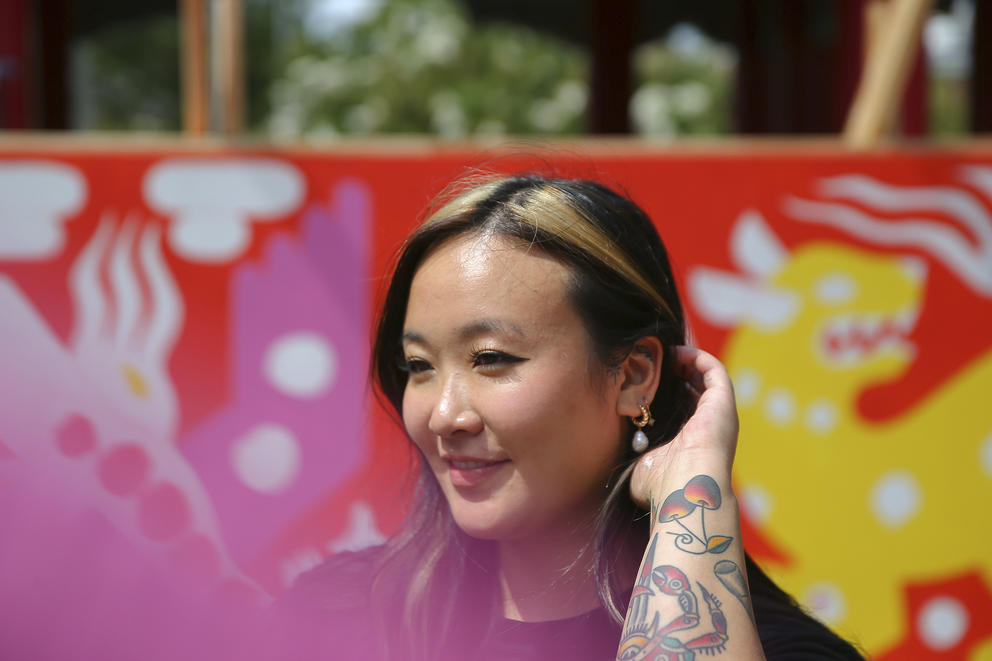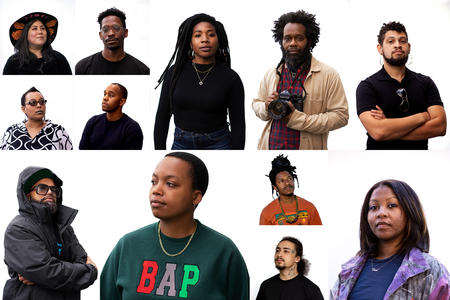Later, she will fill out every inch of the mural with ornate details: flowers, dots, tears and sparkles in Barbie pink, kohl black and marine blue. Somehow, she manages to keep her white painter’s pants pristine in the process.
Blank surfaces usually don’t stay that way for very long when Shao is around. From plywood on closed-up businesses to sprawling restaurant walls, flanks of city buildings and food trucks: In the past year and a half, Shao has covered them all with her vivid, flattened take on flora and fauna, both earthly and mythical. Her style has grown into a recognizable signature — and Shao, at 23 years old, has become one of Seattle’s most recognized and in-demand muralists and illustrators.
“It’s crazy,” she said during a recent interview, as if she were still processing it herself. “I mean, it’s really, really crazy.”
It’s particularly remarkable because until COVID-19 reared its head last spring, she had never painted a mural.
It started with a last-minute assignment from the Ballard Alliance, for which Shao had done some creative work in 2019, during her interior design studies at Seattle Pacific University. It was April 2020, when COVID was soaring, businesses were boarding up and residents were sheltering in place. The murals had to go up quickly, so Shao opted for simplicity: a black cityscape on a white background. On top, she added swoopy pink letters spelling out “It’s gonna be ok.”
The image immediately struck a chord on Instagram and in the minds of anxious Seattleites. It also turned out to be a bit of a premonition for Shao: Since then, her career has been more than OK.
As the pandemic ushered in an explosion of public art Seattle hadn’t seen in years, catapulting new artists into the public eye, Shao’s murals became a recognizable part of the urban landscape.
In the past 12 months, to name a few projects, she has covered the popular Phở Bắc Sup Shop restaurant in Seattle’s Rainier Valley with a warm-toned mural featuring a firebird and flowers (based on a Vietnamese folktale the owners told her); painted a large mural featuring a bull, horse and crane for Re:Public bar and restaurant in South Lake Union; shrouded Pioneer Square’s Metropole building in Northwest marine mammals, fish and birds; collaborated with street art nonprofit Urban ArtWorks and Starbucks; and painted a mobile food pantry for Family Works in a bright, veggie-green pattern.
You can’t miss Shao’s artwork, says Devin Reynolds of the Ballard Alliance, the neighborhood business group that hired Shao to paint that first COVID mural (and two others) last spring. “Her art is colorful, it’s vibrant. It commands your attention because of the boldness,” he says. “It’s not artwork that’s going to get lost in the public realm — it stands out.”
Shao has also ramped up her illustration and graphic design work. She’s designed posters for Chong the Nomad’s sold-out Barboza reopening concert this summer, tide-pool-inspired tote bags for music label Sub Pop, a jacquard blanket for local company Throw & Co., and T-shirts and tote bags for a Seattle Artist Relief fund benefit.
Her reach is also growing beyond Seattle. After discovering her on Instagram, acclaimed American fashion designer Anna Sui used some of Shao’s designs — a pink moon, a white-lettered “Take Care” — for T-shirts, totes and pouches in her spring/summer 2021 collection. A French beer company asked her recently to draw up labels for a few of its sours. She came up with another dynamic duo for the “Monsta Passionista” sour: a deer with pink lightning bolt wings and a yellow-polka-dotted wild boar traipsing around a forest of abstracted, white, blue and yellow foliage against a lipstick red sky.
During a recent visit to her studio, a narrow, two-story building tucked away behind her parents’ Magnolia house, Shao’s trademark bright hues were mostly absent. A few white, primed plywood boards, awaiting coats of flashy paint, leaned against the studio’s white exterior walls.
Shao will paint the boards ahead of the upcoming Seattle Design Fest as part of a two-day art show called Limelight, alongside local artists Nikita Ares, Colleen Louise Barry and Mary Anne Carter at Lake Union Park (Aug. 21-22). In the next few weeks, she’s doing more murals for local businesses, including a new Greenwood brewery —“It’s mural season,” Shao says, in a laid-back manner that belies how swamped her schedule is these days. She’s also working on a project with her sister, Tori Shao, designing way-finding signs and painting murals in the City Centre building in downtown Seattle.
That last project will be a bit of a return: Shao used to work in the building as an interior designer at a local architecture firm (while freelancing as an illustrator and graphic designer for local brands and musiciansm including Parisalexa) until she was laid off last summer because of COVID. Now, she’s a full-time artist.
This new occupation wasn’t something she previously thought possible. As a kid, she excelled in painting intricate scenes in watercolors and acrylics (which she still makes), but the artist-as-career path never seemed viable.
But then she took a life-changing illustration course at Seattle Pacific University, where she also studied interior design. The enthusiastic encouragement from her professor, Seattle illustrator Rachell Sumpter, helped her see a career for herself. “She's the reason why I started developing my style, to a point where it would make sense for a mural or something like that,” Shao says.
Sumpter still remembers how much of a pro and a hard worker Shao already was back then as one of the few students working on a freelance career while still in school. She also struck her as someone who knew how to make an impact.
“She became the art director of this little poetry magazine called Lingua,” Sumpter told me during a recent phone call, referring to the quarterly publication of the student-run art and literary organization at SPU. “To promote it, typically the students will make these little posters, you know, 11 by 17 [inches], that you can create on the photocopier. What she did: she blew hers up — it was like 11 by 14 feet. She blew it up ... and did it over the whole wall of the art center. It was like: Yes! This is it, this is her!” Sumpter says. “She’s not afraid.”
Since then, Shao has leaned into this pack-a-punch style. In her work, negative space has shrunk to the point of horror vacui, and decorative florals have grown into main characters, along with beasts and birds. She’s also less and less afraid of using vibrant colors.
“When I started freelancing, I was making a lot of monochromatic work. Mostly black, white and gray and doing comics and stuff,” Shao says in her studio. She gestures toward a can of Pepto-Bismol pink paint resting near the primed plywood. “When I was younger, as a girl, it wasn’t cool to paint … pink or purple,” she says.
At the same time, she has simplified her style by flattening three dimensions into one plane, similar to the folk art, Chinese ceramics and traditional American tattoos (think: mermaids, anchors, panthers) that inform her artistic approach. Often, she’ll find inspiration on the flash sheets in tattoo shops or on Instagram accounts that catalog traditional textiles from different regions of the world. “The way they're simplified, that’s a sensibility that goes back to graphic design and illustration, and finding different ways to put the information into these little capsules,” she says.
Shao also pulls from research about ecosystems and animal species, as well as Chinese folklore and morality tales (Shao is Chinese American) to inform the creatures she chooses to paint and pair up. Take the tiger and phoenix from Hing Hay Park: “It alludes to a supernatural world. It’s heaven and earth,” she says. “That’s a big theme in Chinese mythology.”
For a recent mural at Cal Anderson Park, she zoomed in on the relationship of deer and rabbits. “The idea with this piece was to tell a story about these two species and their working (and playing) relationship,” she says. “Rabbits and deer live and feed in many of the same areas and have mutualistic feeding and alarm systems, where they rely on one another for cues over danger and food. This relationship applied to the idea of ‘stronger together,’ that there’s much we can learn from the natural world.”
Plus, she adds, “Something I wanted to add to my process is this ‘world building’ aspect, where characters and symbols make repeated appearances in different combinations to tell different stories.”
Currently on the horizon: T-shirts, tote bags and sweatshirts for local businesses, including Monorail Espresso; a group show of art on coasters; welcome back banners for Downtown Seattle; a mural for the Showbox in SoDo this winter. “I’m also working on a special jersey for an unnamed Seattle team that will be released sometime in March or April that I’m really stoked for,” Shao adds.
But just as Shao’s new works are popping up all over, some of her early work on plywood covering closed businesses has come down. She’s not sure what happened to many of those COVID murals. But, she says, it’s been a year of both artistic and personal growth. She has learned to accept that some things serve a certain purpose at a certain time — and that’s true for murals, too.
“It doesn’t have to continue to live on in any form — it could just be gone; be thrown away. And that should be fine,” she says. “They served that purpose. They brought a bunch of color to the street. That should be enough.”
Get the latest in local arts and culture
This weekly newsletter brings arts news and cultural events straight to your inbox.

